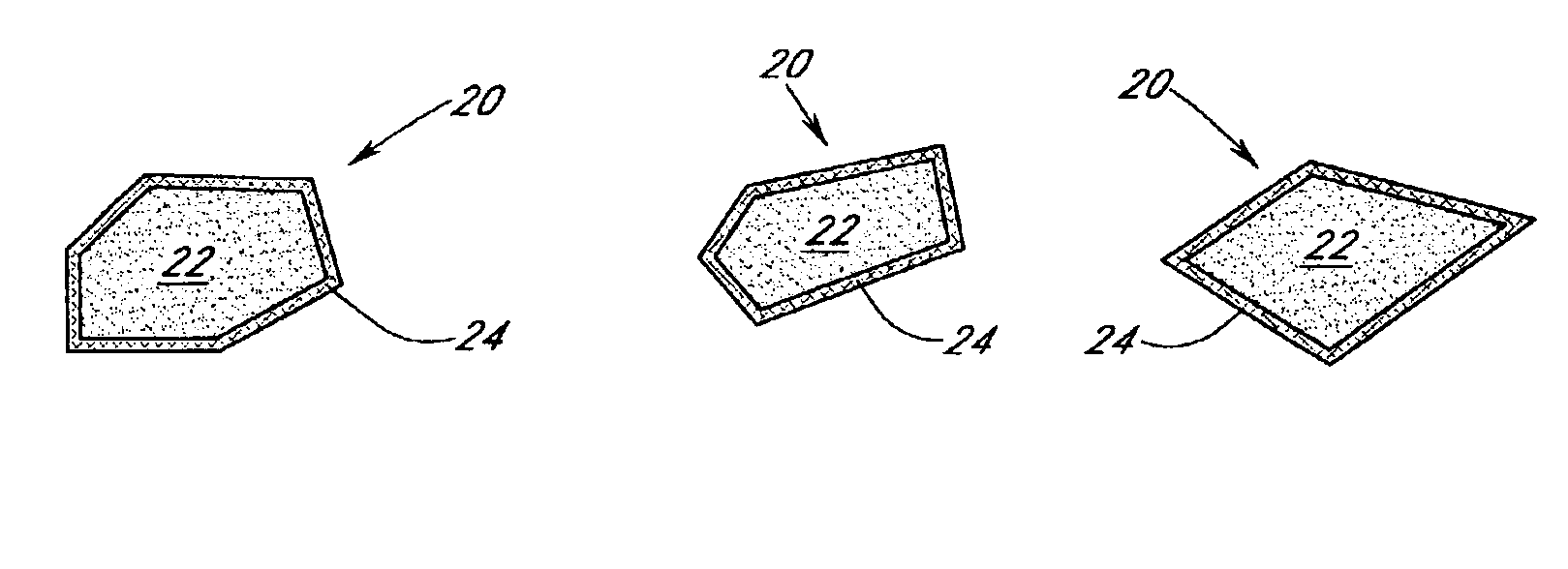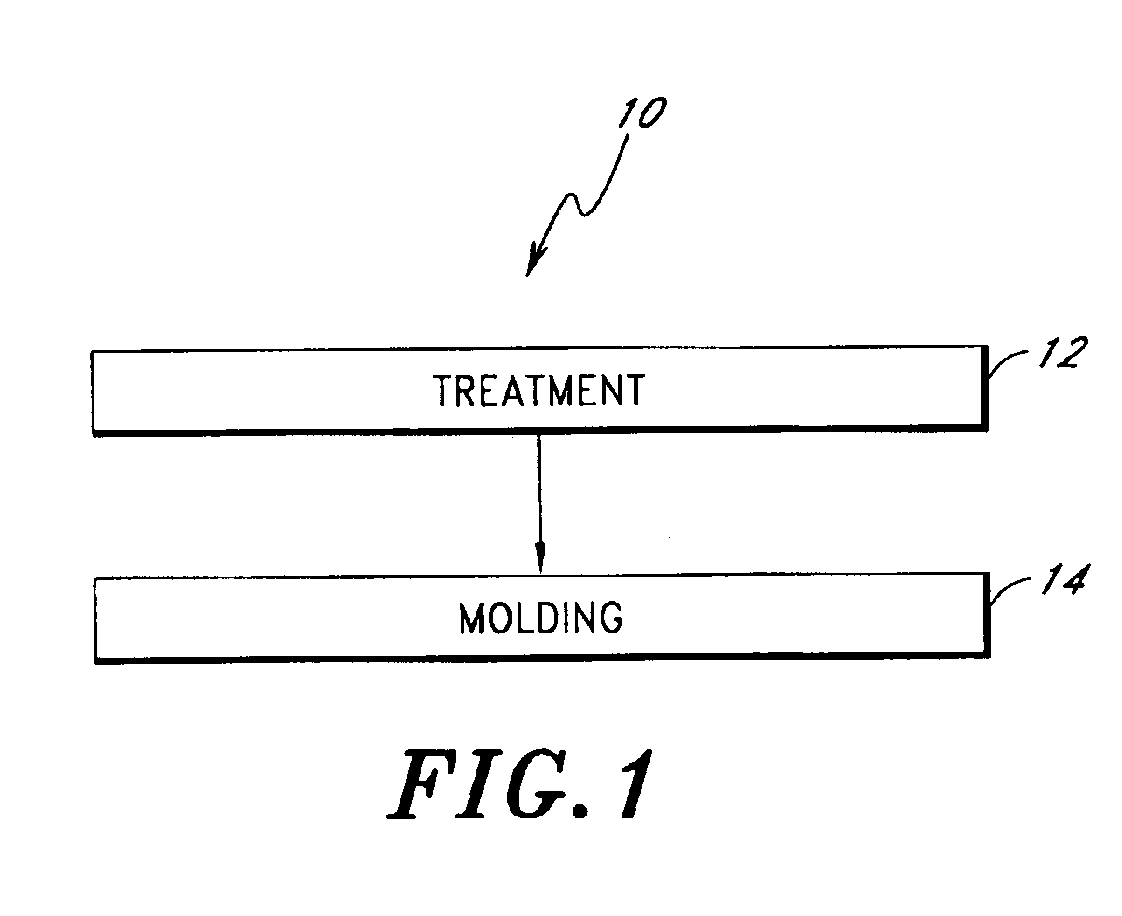Treated rubber and products made therefrom
a technology of rubber and products, applied in the field of compostable rubber products, can solve the problems of lower tensile strength of finished products made with rubber with a high water content, and the inability to use rubber treated for vulcanization in the polyurethane binder process, so as to achieve less binder, lower tensile strength and/or elongation, the effect of cost saving
- Summary
- Abstract
- Description
- Claims
- Application Information
AI Technical Summary
Benefits of technology
Problems solved by technology
Method used
Image
Examples
example 1
Comparative Cold-Cure Results
[0054]The effect of different rubber treatment procedures on the tensile strength and elongation of the final product was tested. Each rubber sample was treated under the conditions provided in the “Binder,”“Time,”“Temp.,”“Catalyst,” and “Additive” columns of TABLE I. Typically, 800 g of crumb rubber—1-4 mm for EPDM samples and 1-3 mm for SBR samples—were treated in each entry, except for Entry 32 (1100 g) and Entries 15-17 (250 g). Test samples were made from each of these treated rubber samples by a cold-cure process as follows. A 375-g sample of the treated rubber was mixed for 90 seconds with 67.5 g of a one-part MDI urethane binder (T-424, Ryvec, Anaheim, Calif.) and 2.3 g of water using a Kitchen Aid Heavy Duty mixer (Model K5SS). The resulting mixture was poured into a 7″×10″×½″ aluminum mold lined with aluminum foil and leveled. The filled molds were placed on a 95° F. platen for 10 hours. Each sample was allowed to cure for 10 days at room tempe...
example 2
Comparative Hot-Cure Results
[0067]The results provided in TABLE IV and TABLE V compare samples made by the disclosed process and by the commercial process under hot-cure conditions. For each set of conditions, three ¼″×6″×6″ samples were molded, and three specimens cut from each sample for tensile strength testing (nine specimens for each set of conditions). The rubber used in these experiments was SBR. The “Rubber” column indicates the conditions under which the treatment step was performed. The “Binder,”“Temp.,”“Time,” and “Mold Pressure” columns indicate the conditions under which the molding step was performed. The “Tensile Strength” column indicates the average tensile strength for samples made under the specified conditions.
[0068]TABLE IV compares the effect of using different amounts of binder in the treatment step. For the treated rubber, the amount of binder used in the molding step was adjusted such that the total amount of binder used was 2.5%. For the standard and dried ...
example 3
Animal Mats
[0076]The following is a typical large-scale rubber treatment procedure. Ground rubber was preheated to 150° F. and combined with 1% MDF-403 binder (Ryvec, Inc., Anaheim, Calif.) with constant mixing in a jacketed ribbon mixer equipped with a double spiral ribbon. Treatment was complete in about 15 minutes.
[0077]100 lb of 1% treated rubber was mixed with 15 lb MD-400 binder (Ryvec, Inc., Anaheim, Calif.) for 1 minute. The mixture was placed into molds (¾″×4′×8′) and leveled. The molds were placed into a press with heated platens for 7 minutes at 150 psi and 280° F. The mats reached full tensile strength in about 24 hours.
[0078]A mat 30 is shown in cross-section in FIG. 3. Treated rubber particles 20 are made of rubber particles 22 coated with the first urethane binder 24. The treated rubber particles 20 and a second urethane binder 32 form a rubber composite that forms the mat 30. The mat may have voids 34, the size of which will depend on factors including the size and s...
PUM
| Property | Measurement | Unit |
|---|---|---|
| temperature | aaaaa | aaaaa |
| pressure | aaaaa | aaaaa |
| pressure | aaaaa | aaaaa |
Abstract
Description
Claims
Application Information
 Login to View More
Login to View More - R&D
- Intellectual Property
- Life Sciences
- Materials
- Tech Scout
- Unparalleled Data Quality
- Higher Quality Content
- 60% Fewer Hallucinations
Browse by: Latest US Patents, China's latest patents, Technical Efficacy Thesaurus, Application Domain, Technology Topic, Popular Technical Reports.
© 2025 PatSnap. All rights reserved.Legal|Privacy policy|Modern Slavery Act Transparency Statement|Sitemap|About US| Contact US: help@patsnap.com



